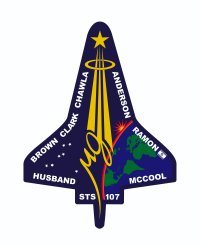Thu, Jan 30, 2003
STS-107 Report #14; Tuesday, January 28, 2003 -- 5 p.m.
CST
 The Red team of astronauts aboard the Space
Shuttle Columbia accomplished repairs on the third and
final combustion experiment of STS-107 this afternoon, and support
scientists on the ground were looking forward to working with the
Blue team on the first scientific runs.
The Red team of astronauts aboard the Space
Shuttle Columbia accomplished repairs on the third and
final combustion experiment of STS-107 this afternoon, and support
scientists on the ground were looking forward to working with the
Blue team on the first scientific runs.
Mission Specialist Kalpana Chawla reported a good leak check of
the Combustion Module-2 Facility about 4 p.m. after five hours of
work. She and Commander Rick Husband sent down video of the
recovery procedures for the Water Mist Fire Suppression Experiment
(MIST) around 2 p.m. to give engineers on the ground an opportunity
to visually inspect the equipment. The combustion facility, which
provides control, containment, diagnostics and communications for
fire-related experiments, worked flawlessly in support of the two
previous combustion experiments, but failed its initial leak checks
when MIST was installed Monday.
Payload Commander Michael Anderson of the Blue team is scheduled
to begin work with the MIST experiment overnight. Designed by
the Center for Commercial Applications of Combustion in Space at
the Colorado School of Mines, Golden, Colo., the experiment will
investigate how water mist inhibits the spread of flames.
Scientists hope to apply what they learn to designs for improved,
lighter-weight fire suppression systems on Earth, as well as for
spacecraft-based systems that won’t require ozone-damaging
chemicals such as Halons.
 Husband, Chawla and Red team colleagues Lauren
Clark and Ilan Ramon enjoyed some time off for the first half of
their day, then moved ahead with other experiments in the Spacehab
Research Double Module. Clark retrieved samples associated with the
Bioreactor Demonstration System, which Project Scientist Tom
Goodwin reported today has grown a bone and prostate cancer tumor
tissue sample as large as a golf ball, the largest grown in space
to date. She also collected blood and urine samples from her
crewmates for the Physiology and Biochemistry (PhAB4) suite of
experiments. Ramon also conducted observations of dust off the
African coast for the Mediterranean Israeli Dust Experiment
(MEIDEX).
Husband, Chawla and Red team colleagues Lauren
Clark and Ilan Ramon enjoyed some time off for the first half of
their day, then moved ahead with other experiments in the Spacehab
Research Double Module. Clark retrieved samples associated with the
Bioreactor Demonstration System, which Project Scientist Tom
Goodwin reported today has grown a bone and prostate cancer tumor
tissue sample as large as a golf ball, the largest grown in space
to date. She also collected blood and urine samples from her
crewmates for the Physiology and Biochemistry (PhAB4) suite of
experiments. Ramon also conducted observations of dust off the
African coast for the Mediterranean Israeli Dust Experiment
(MEIDEX).
More News
With Testing Soon Complete, Launch Preparations Begin in Earnest Sierra Space's Dream Chaser has been put through the wringer at NASA's Glenn Armstrong Test Facility in Ohio, but w>[...]
Takeoff Roll The process whereby an aircraft is aligned with the runway centerline and the aircraft is moving with the intent to take off. For helicopters, this pertains to the act>[...]
“We’re proud of the hard work that went into receiving this validation, and it will be a welcome relief to our customers in the European Union. We couldn’t be mor>[...]
"Aircraft Spruce is pleased to announce the acquisition of the parts distribution operations of Wag-Aero. Wag-Aero was founded in the 1960’s by Dick and Bobbie Wagner in the >[...]
IDENT Feature The special feature in the Air Traffic Control Radar Beacon System (ATCRBS) equipment. It is used to immediately distinguish one displayed beacon target from other be>[...]
 Sierra Space Repositions Dream Chaser for First Mission
Sierra Space Repositions Dream Chaser for First Mission ANN's Daily Aero-Term (05.10.24): Takeoff Roll
ANN's Daily Aero-Term (05.10.24): Takeoff Roll Aero-News: Quote of the Day (05.10.24)
Aero-News: Quote of the Day (05.10.24) Aero-News: Quote of the Day (05.11.24)
Aero-News: Quote of the Day (05.11.24) ANN's Daily Aero-Term (05.11.24): IDENT Feature
ANN's Daily Aero-Term (05.11.24): IDENT Feature




